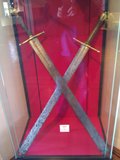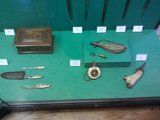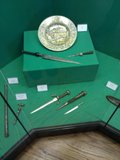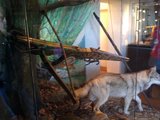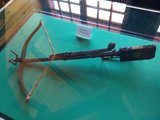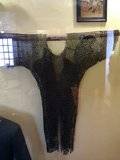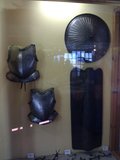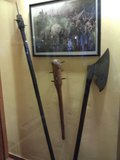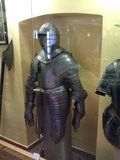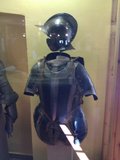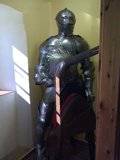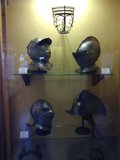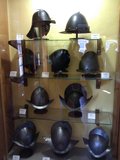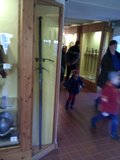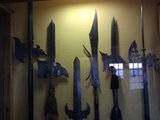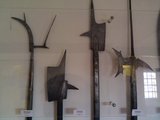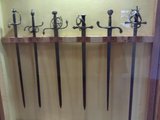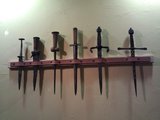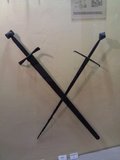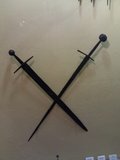Posts: 70 Location: Las Vegas, NV
Thu 10 Mar, 2011 8:27 pm
Weapons & Armor from Schloss Burg
Last edited by Neil Schiff on Thu 10 Mar, 2011 8:30 pm; edited 1 time in total
Posts: 70 Location: Las Vegas, NV
Thu 10 Mar, 2011 8:29 pm
Posts: 119 Location: Reno, NV
Thu 10 Mar, 2011 10:47 pm
I like the type Z(?) pommel in the second to last pic. Thanks for sharing!
BTW, Schloss Burg translates as "Castle Castle", so Schloss Burg castle is "Castle Castle castle" - twice a tautology.
Posts: 7 Location: Munich
Fri 11 Mar, 2011 12:29 am
Sorry, but as a native German speaker, I must object. A "Schloss" is a palace which is not fortified in any way, while a "Burg" is a fortified castel. So the correct translation is "palace castle". Still wierd, since it is fortified.
Posts: 396 Location: Germany
Fri 11 Mar, 2011 1:07 am
I think it is a little bit more complicated, than Robert has pointed out. Usually no german would call a palace without a fortified wall a Burg (castle).These are Schlösser or a Schloss. But ever so often we are calling walled castles a Schloss, when itself has no name but is named after the place it was build. I think this dates back into the 19th century, when tourism started and every town wanted to advertise itself with a palace instead of a mere castle. It just sounds more impressive to say "Schloss" instead of "Burg". Where I live, we have both naming-schemes: The walled castles "Alsbacher Schloss", "Auerbacher Schloss" or "Heidelberger Schloss" are called a Schloss but have fortifications. The Burg Frankenstein instead is called after the family, which lived there (but it has high walls too).
Schloss Burg an der Wupper is also a fortified castle on a mountain top, named after the town nearby and not after the family (they were called Von Berg, which means "of mountain - the place where their castle stood) Funny thing is, I guess the town was once named after the castle "Burg" and then the castle itself was renamed after the town... And so on...
In short: There is no need to translate the name of "Burg" in this case. You would call it in englisch properly Castle Burg (at the Wupper).
I hope you could follow my trail of thoughts...
:)
Thomas
Posts: 671 Location: The Netherlands
Fri 11 Mar, 2011 1:31 am
Nice pictures. But what's up with the two strange longswords in the second picture of the first post? They have strange, short fullers and no tip. Are they some sort of training/tournament swords?
Posts: 45 Location: Germany
Fri 11 Mar, 2011 2:16 am
| Sander Marechal wrote: |
| Nice pictures. But what's up with the two strange longswords in the second picture of the first post? They have strange, short fullers and no tip. Are they some sort of training/tournament swords? |
Hello Sander,
I guess those are executioner´s swords. Enlarging the image as much as possible I can just deciper the small note saying "Richtschwerter", unfortunately the date is not legible.
The pictures are very interesting. So many museums and castles still to visit....
Posts: 671 Location: The Netherlands
Fri 11 Mar, 2011 3:23 am
| Markus Nußbaumer wrote: |
| I guess those are executioner´s swords. Enlarging the image as much as possible I can just deciper the small note saying "Richtschwerter", unfortunately the date is not legible. |
Ah, yes. I thought it said "Ritterschwerter".
Posts: 396 Location: Germany
Fri 11 Mar, 2011 3:30 am
| Markus Nußbaumer wrote: |
| Sander Marechal wrote: | | Nice pictures. But what's up with the two strange longswords in the second picture of the first post? They have strange, short fullers and no tip. Are they some sort of training/tournament swords? |
Hello Sander,
I guess those are executioner´s swords. Enlarging the image as much as possible I can just deciper the small note saying "Richtschwerter", unfortunately the date is not legible.
The pictures are very interesting. So many museums and castles still to visit.... |
Jepp, definitely executioners swords (Richtschwerter).
Posts: 1,248 Location: New Mexico
Fri 11 Mar, 2011 5:37 am
Neat Welsh hook. What an odd weapon. Thrusting with that thing looks as if it'd be tricky.
Posts: 119 Location: Reno, NV
Fri 11 Mar, 2011 5:38 am
The primary definition of castle in English is a mediaeval fortification. However, like it or not the term is also used for many opulent, non-fortified residences such as Castle Howard, Neuschwanstein Castle, or even Hearst Castle in California. One could therefore translate both Burg and Schloss as castle.
Castle Burg is probably the best translation, but who could pass up the chance to call something Castle Castle Castle?
Posts: 89 Location: Czech republic
Fri 11 Mar, 2011 12:20 pm
Schloss versus Burg
Interesting discussion!
English language doesn´t know the difference between "schloss" and "burg", both mean "castle".
But in Europe we distinguish "schloss" from "burg" and have another term - "festung" (= fortress).
Burg is medieval fortified castle.
As the time went by, the tactics of battles changed. There was no need for fortification any more, and "die burgen" (castles) were rebuilded into more comfortable mansions for aristocracy - "schlosses". But still, some "schlosses" have also some elements of defences.
The term "festung" (fortress) can be "just a fortress" - or "festung" which consists of the whole town (whole town is "the the middle of the fortress").
Really fine fotress is Festung Königstein in Saxon, Germany (http://www.festung-koenigstein.de/index.php/welcome.html)
Another term is "palace", it´s used for a spectacular residence in the city.
It´s just complicated :-)
PS: I also think 2 swords on the picture mentioned above (pic. 2) are executioner sword.
The reason for "weird" tip is, that executioners tied the weight (plumb/ plummet - sorry don´t know english expression) through this tip (there used to be little holes in the tips), so that they had a better "whip/chop" (for better "separation of a head form a neck").
Cheers, Michal
Posts: 26 Location: Pittsburgh, PA
Fri 11 Mar, 2011 2:07 pm
Neil, thank you for sharing the pictures. I know how hard museums make photography.
Do you know what the little knife beside the bayonet in the 6th picture of the first group is?
Well, that sentence was the proud product of the American Public School system, let's try that again.
In the 6th picture of the first group there is a display with a plate, a plug bayonet and a little knife with a strange attachment. Do you remember what the knife was?
Posts: 70 Location: Las Vegas, NV
Sat 12 Mar, 2011 8:07 pm
| Marc Bloom wrote: |
Neil, thank you for sharing the pictures. I know how hard museums make photography.
Do you know what the little knife beside the bayonet in the 6th picture of the first group is?
Well, that sentence was the proud product of the American Public School system, let's try that again.
In the 6th picture of the first group there is a display with a plate, a plug bayonet and a little knife with a strange attachment. Do you remember what the knife was? |
Sorry, I have no idea. Everything was labeled in german and, as far as I could tell (I was visiting with some Germans), they were basically just "knife, 17th C", etc.
Posts: 89 Location: Czech republic
Sun 13 Mar, 2011 11:38 am
hunting dining cutlery
Knife on the 6th picture of the 1st group beside the bayonet looks like it could be a knife from hunting dining cutlery, the 17th C...sorry the photograph isn´t a better quality.
You
cannot post new topics in this forum
You
cannot reply to topics in this forum
You
cannot edit your posts in this forum
You
cannot delete your posts in this forum
You
cannot vote in polls in this forum
You
cannot attach files in this forum
You
can download files in this forum

